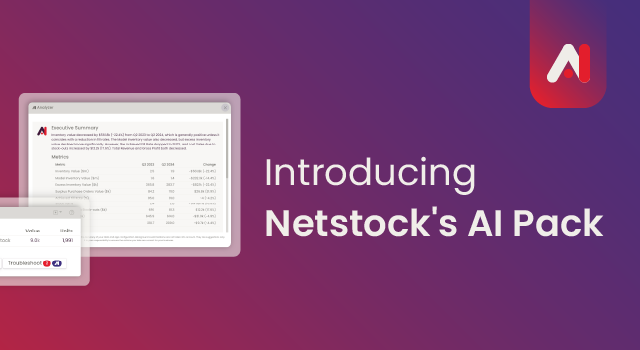What’s in this blog?
The picture of a typical modern supply chain operation is one of unrestricted movement of goods across different facets and levels of the supply chain. It was designed to ensure that as long as there are orders, the supply chain can and will be able to supply. This is why inventory replenishment is essential. How can your supply chain work if it has no inventory to supply?
What does inventory replenishment mean, though?
Replenishment is the process of restocking something when it is depleted. In the context of business and supply chain management, inventory replenishment specifically refers to restocking inventory after it has been depleted.
No business or supply chain can hold an infinite amount of inventory. Every demand fulfilled by the supply chain reduces its inventory quantity. If inventory is not replenished, the supply chain will be unable to meet demand, leading to disruptions, downtime, and lost sales opportunities.
Therefore, having a robust system for inventory ordering and replenishment is essential. It plays a crucial role in ensuring the continuous flow of goods across the supply chain, enhancing operational efficiency and customer satisfaction.
In this article, we’ll discuss some of the best practices for inventory replenishment.
Leveraging technology for precision in inventory management
It’s no secret that technology plays a crucial role in modern supply chain management. Thanks to its integration into supply chain processes, operations are faster, more seamless, and optimized than traditional methods, impacting the entire supply chain, including inventory management.
By leveraging technology in your inventory management process, such as inventory ordering or replenishment, you can expect to have a highly optimized inventory management experience.
A key technology application for such a process is the warehouse management system. It’s a robust technology solution available for inventory control and effectively simplifies the inventory replenishment process. The platform helps businesses and supply chains organize, control, and track inventory.
Managing the flow of inventory across a supply chain can be challenging when relying on traditional methods. While manual records are available, they are prone to errors, and it takes a considerable amount of time to get an accurate picture of the inventory on hand. These records could include various forms of documentation, such as handwritten logs, digital spreadsheets, or other systems used to record inventory movements and levels. It’s a lot of work, and this is where the Warehouse Management System (WMS) comes into play.
With the WMS, you have a platform that is especially useful in inventory replenishment because it provides a real-time overview of your inventory’s status. WMS is popular because it can monitor the inventory process and alert you when you are approaching the reorder point or low stock levels. The right integrations can help initiate the inventory replenishment process.
Modern warehouses rely on technology to optimize inventory replenishment, which has become a crucial strategic advantage. Warehouse Management Systems (WMS) provide valuable insights into inventory levels, demand patterns, and lead times. Although WMS typically rely on periodic data updates, they still enable precise replenishment orders, reducing the risk of stock-outs or excess inventory. Technology-driven replenishment strategies such as Just-in-Time (JIT) and Vendor-Managed Inventory (VMI) further improve inventory levels. These strategies reduce holding costs and improve operational efficiency, elevating the inventory replenishment process from a reactive task to a proactive, data-driven process. Therefore, modern warehouses must embrace technology to remain competitive.
Demand forecasting: The cornerstone of replenishment strategies
Effective demand forecasting is crucial to any inventory replenishment strategy. It’s the ability to predict the future behavior of customers regarding your product or services. Knowing this will allow you to plan your inventory replenishment strategy. More demand typically means more inventory; less demand will ultimately mean less inventory.
Accurate demand forecasting eliminates waste and lost revenues in the supply chain. Beyond forecasting demands, you want an accurate forecasting system. It will primarily help with inventory optimization, effective resource allocation, risk mitigation, and enhanced production efficiency. However, getting it right means leveraging the right tools and applications.
Another role technology plays in the inventory management process is analyzing customer behaviors and conditions, such as weather, season, and geopolitics. Solutions that offer features such as advanced analytics, machine learning, and artificial intelligence functionality effectively analyze these conditions, giving you a comprehensive overview of what to expect from customers.
You can accurately estimate why the demand will rise, fall, or remain the same, allowing you to plan your replenishment properly.
When planning inventory replenishment, you must automatically consider your EOQ Formula (economic order quantity) and Reorder Point Formula for greater accuracy.
With the EOQ, you can identify the ideal order quantity that puts your inventory in the sweet spot between holding and ordering costs. It’s your ideal order quantity that does not impact your supply chain with costs.
You need to understand the formula:
EOQ = √(2DS / H)
- EOQ: Economic Order Quantity
- D: Demand
- S: Ordering Cost
- H: Holding Cost
The reorder point is the inventory level that triggers the initiation of a new inventory.
Here is the formula:
ROP = Lead Time Demand (LTD) + Safety Stock
- ROP: Reorder Point
- LTD: Average demand during the lead time (that is demand X lead time)
- D: Demand
- Lead Time: Time between order and delivery
- Safety Stock: Buffer stock that accounts for unexpected fluctuations in demand and lead time
Strategic replenishment planning: Adapting to market dynamics
Markets are always changing, regardless of the sector. Some change more frequently than others, but in general, given enough time, every market will shift. That’s why it’s important to periodically review and adjust replenishment strategies. This helps your supply chain remain resilient to fluctuations in demand.
Adapting or adjusting your replenishment strategy to marker dynamics allows you to avoid excess inventory costs and ensure customer satisfaction by getting your customers their products on time and in the right amount.
Studying an evolving market can be challenging. However, you can leverage artificial intelligence and machine learning technology. These types of technology help provide a detailed analysis of market behavior. This way, you are better informed, one step ahead, and ready for the shift when it happens.
Understanding your EOQ comes in handy here. EOQ calculators help you automate complex formulas to get the right replenishment strategy, thereby reducing errors and saving time.
Collaborative efforts in streamlining replenishment processes
If technology is the lifeblood of the modern supply chain, collaboration is its bedrock. You would be hard-pressed to find any modern supply chain that does not strategically collaborate with suppliers and other parties across its operations. Collaboration is particularly effective because it helps streamline the inventory replenishment strategy.
Collaboration breeds communication, creating visibility between all supply chain parties. It helps the business or supply chain understand potential challenges that could impede the replenishment process on time and then take steps to mitigate them.
One of the most effective collaboration tools is the CPFR. That is the Collaborative Planning, Forecasting and Replenishment framework. This system allows for effective collaboration between a supply chain, its suppliers, and the retailers.
The idea is that instead of working independently, these parties share relevant data to properly plan, track, and forecast the inventory flow. However, three things must be in place for it to work: open communication, trust, and substantial investment in technology.
The framework is popular for various reasons, such as ensuring low inventory costs, accurate forecasts, improved supply chain efficiency, and better customer satisfaction.
Diversifying replenishment methods to match business needs
There are generally three replenishment methods. The top-off, periodic, and on-demand replenishment methods. Although businesses favor one at any given time, it is important to consider diversifying them to match their needs.
Top-off replenishment method: This involves replenishing inventory to predefined levels whenever stock falls below a certain threshold. It ensures consistent product availability and prevents stock-outs, making it suitable for maintaining steady inventory levels for fast-moving items.
Periodic replenishment method: Here, inventory is replenished at regular intervals, such as weekly or monthly, regardless of current stock levels. It simplifies inventory management and order processing, making it ideal for items with predictable demand patterns and stable consumption rates.
On-demand replenishment method: In contrast, the on-demand method triggers replenishment orders only when customer demand is confirmed, typically through sales orders or forecasts. It offers flexibility and responsiveness to fluctuating demand, reducing excess inventory and storage costs, but requires accurate demand forecasting and agile supply chain processes.
Selecting the best replenishment method depends on a number of factors, such as:
- Demand patterns: Businesses with predictable demand may prefer periodic replenishment; those with unpredictable demand may lean towards on-demand methods.
- Inventory turnover rate: Fast-moving items are suited to on-demand replenishment to avoid stock-outs, while slow-moving items fit periodic replenishment to prevent excess inventory.
- Lead times: Short lead times benefit from on-demand replenishment for quick response, while longer lead times might require periodic replenishment for stock availability
- Storage space and costs: On-demand replenishment can reduce storage needs and costs, making it attractive for limited space or high-cost scenarios.
- Labor costs: Automating replenishment processes and optimizing labor can lower labor costs, benefitting high-volume or labor-intensive environments.
Optimizing policies and technologies for effective replenishment
Although inventory replenishment is an effective tool, its application in inventory management operations is more critical. Inventory replenishment starts with choosing the right inventory management policy.
Three common inventory replenishment policies could make or break your inventory management setup. Implementing them with the right software helps smooth the entire process.
- Min/Max: Set minimum (Min) and maximum (Max) stock levels. The chosen software monitors levels and triggers orders when the stock dips below Min. It does something similar when it reaches the Max.
- Periodic Order-Up-To (OUT): Regularly review stock and order enough to reach a predetermined “order-up-to” level, considering demand until the next review. The software automates these reviews, calculates order quantities, and generates purchase orders.
- Reorder Point (ROP)/Order Quantity (EOQ): Order when inventory reaches the ROP (to avoid stock-outs during lead time) for the predetermined EOQ (ideal order quantity). The software automates calculations and generates orders when ROP is reached for the EOQ amount.
Selecting the right replenishment software is crucial for optimizing inventory management and streamlining operations.
Here’s why:
- It automates calculations and order generation, thereby reducing errors and saving time.
- It provides real-time visibility into inventory levels. This, in turn, ensures timely orders.
- It should integrate with data to suggest optimal order points and quantities.
- It minimizes overstocking and understocking, leading to lower costs.
Replenishment software offers more than just automating the reorder process. It plays a crucial role in key inventory management operations, which involves balancing inventory levels, predictive demand forecasting, supplier management, and having the visibility to monitor inventory KPIs. Additionally, this software assists in recommending the most suitable replenishment method tailored to your supply chain and inventory management operation. The software is scalable, ensuring it can evolve alongside your business needs. It’s vital to select a solution that aligns with your business needs and integrates smoothly with your existing processes.
Mastering inventory replenishment for business success
Throughout the article, we discussed the best practices for inventory replenishment and the significant improvements they can bring to business and supply chain operations, including preventing stock-outs, reducing costs, and enhancing operational efficiency. However, managing inventory replenishment in the modern supply chain can be challenging without the right software. These tools and applications can automate inventory replenishment tasks, provide data-driven insights to facilitate better decision-making, and effectively scale your business.




